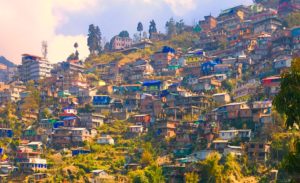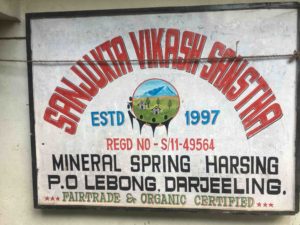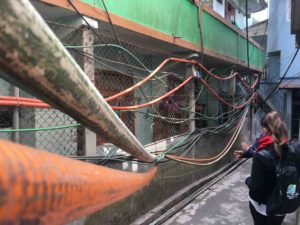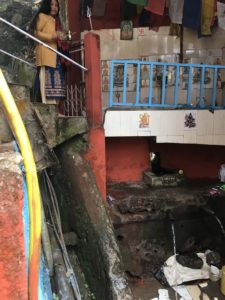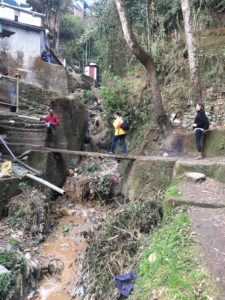I’ve recently visited Darjeeling with a group of CLiGS graduates students studying sustainability. It was an old hill station built in the Himalayan mountains by British colonizers wanting to escape India’s summer heat. It remains the site of colonial-era plantations that grow world-famous Darjeeling tea. It turns out, harvesting and processing the tea exploits workers (surprise!), especially women (surprise!), some of whom have been living in plantation-provided housing for 8 generations: workers can earn as little as a dollar a day and live in houses provided by their employers and are given allowances for food and certain household necessities—all in partial payment of wages. These sorts of human rights, inequities, cast, and social justice issues permeate all of India, not just the tea plantations. However, the power of big money buying political protection makes this instance seem even ickier. And it’s blatant: several dozen large plantations produce all the Darjeeling tea, so power is concentrated in a few companies who are difficult to influence because they are private and don’t have shareholders.
Consumer-facing product certification is having an impact. Most of the plantations went organic not long after Germany returned a shipment of tea because it contained unsafe levels of pesticides. Fascinatingly, and something I don’t fully understand, the plantation tea is certified as “Fair Trade,” a certification I thought is supposed to signal social justice. Apparently, the tea-lobby was powerful enough to create a special category for large scale industrial grown/produced foods. Fair Trade, it seems, has very different standards for workers of plantations than workers of small farms.
We met community leaders and farmers at Mineral Springs Tea Plantation, a group of hamlets/communities outside of Darjeeling who grow organic tea along with vegetables and other crops using an integrative agriculture called “permaculture” that mixes and rotates crops co-mingled horizontally and vertically, including fruit trees, tea bushes, coriander, cauliflower, and ginger. The dense, lush, diverse farms stand in stark contrast to the plantations’ vast acreages of monoculture exposed to full sun. And, as far as I can tell, the labor practices seem fairer.
But despite Darjeeling being synonymous with tea, and the compelling stories of social justice and community organizing, I’ve been more moved by the extremely charismatic, brightly colored, high-density, low-rise neighborhoods nestled tightly against the steep slopes of the Himalayan foothills. The houses are eclectic, to say the least: each one unique. Most have multiple stories with overhangs, each one clinging to the slope on one side and looking out onto the valley deep below, on the other. Neighborhoods are more vertical than horizontal and a maze of uneven steps and walkways connect them. They exemplify organic architecture. Most of the neighborhoods are busties, recognized informal settlements, but where most homeowners now have relatively secure property rights.
More specifically still, I was moved by the water infrastructure within these busties. The municipal governance must be too weak and too overwhelmed by growth to manage the basic necessities of fresh water and sewage. Municipal water runs only a few hours a week, so the city is draped by gravity-fed plastic pipes that middle-income homeowners use to connect their homes to water springs located somewhere uphill. The wealthiest families have additional and larger pipes, connecting their homes to ports where private businesses truck in the water on a regular basis, for a fee. The poorest families have no pipes, children fetch the household’s water from springs before going to school. It’s a city with more water tanks per building than people per building: water and water storage dominate everything. It is more than a daily necessity: water has deep significance to Hinduism so shrines and temples adorn most springs.
Raw sewage is juxtaposed amidst this maze of pipes, stairs, shrines, and beautiful architecture. The smallest units of neighborhoods coordinate among themselves so that most all homes connect their toilets to sewage pipes that run downhill away from family and neighbors, but some pipes leak or terminate uphill of other neighborhoods, filling the many open steep, narrow, concrete channels designed to move heavy monsoon rains out of harm’s way with rivulets of sewage. All pipes eventually end, so all the sewage flows untreated into the creeks and rivers below town, where much of the city’s fresh food is grown.
The accumulation of single-use plastic is overwhelming–wrappers, bags, bottles accumulate in all drainages. Darjeeling has its own Victoria Falls, which was a tourist attraction half a century ago, clear and fast flowing, but is now a trickle of brown water and plastic. When the monsoons come, it all gets cleaned out and washed away downstream–out of sight and out of mind, a fresh start each year! But it all goes somewhere.
I’m now in city called Gangtok, several hours north, in a different state (Sikkim). It is the state’s capital and although slightly smaller than Darjeeling, it clearly has a different level of governance efficacy and funding. I’ve not toured the infrastructure as thoroughly, but what I’ve seen suggests a strikingly different water/sewage system. Pipes connecting homes to springs are still used, but less so because the municipal water system is much more effective. Neighborhoods and waterways nestled into the steep hills are much less polluted, at least by plastic. And sewage pipes lead to a centrally located sewage treatment plant, at least for the main city.
Witnessing the water, sewage, and fairness challenges described above re-affirms to me that some issues can’t be solved by individual responsibility or reducing governance to the smallest local level. Some issues are collective problems that require coordinating across an entire city/region/nation/globe. Some people in the US ignore the irreducibility of problems and the need for good governance precisely because past governance has been up to the task of providing basic necessities, including a relatively clean and healthy environment.
In the US, when people question big government and tout individual responsibility, they usually want to fire up the base. They want to widen a political divide that polarizes collective action. They offhandedly discredit governance and government just to score political points. They don’t seem to know why they’ve got things so good. Perhaps they should travel more.
